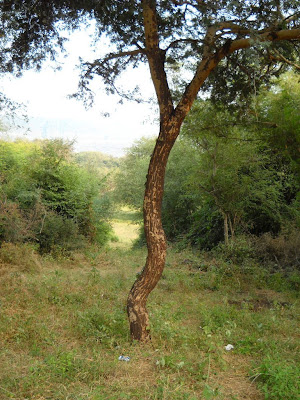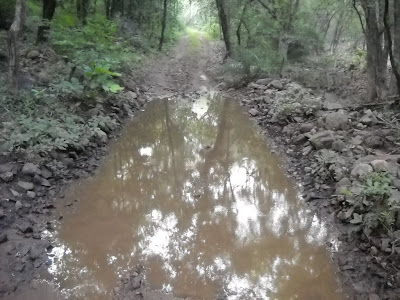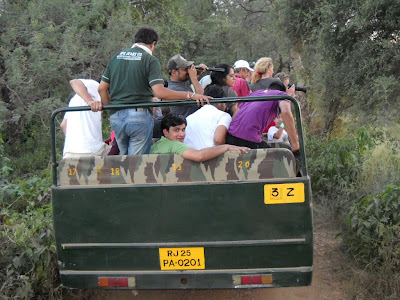












 One sees shrines, churches and cathedrals everywhere in Goa -- some brilliant and shining in the sun; others mildewed, shuttered and garlanded with dried marigolds.
One sees shrines, churches and cathedrals everywhere in Goa -- some brilliant and shining in the sun; others mildewed, shuttered and garlanded with dried marigolds.
Our guidebook said we shouldn't miss the Basilica of Bom Jesus so we hired a taxi to take us there. Our driver, Freddie, was informative and helpful, but it was a very hot and humid day. By 1 pm we were wilting and wanting only to find an air-conditioned place to have some lunch. He laughed at us when we told him we were ready to go back to the hotel after a brief stop at an Emporium. "I thought you came from a hot climate!" he exclaimed. "But it's dry in the desert," we tried to explain and I'm sure it sounded pretty lame.
But we're glad we visited the famous 500 year old church. It's a huge structure made of reddish-black laterite stone which is quarried in Goa itself, as well as wood and marble. If you want to read more about it, you can find things online. It's worth reading about and the government of India's website, Know India, has a nice little article on it.
Most interestingly, it is where the body of St. Francis Xavier, who died in Goa in 1522, lies enbalmed and set high up in a sealed glass coffin. Once every 10 years it is brought down for public viewing.
In speaking with the Catholic women who work at Goa Beach House where we stayed, we learned that they attributed the protection Goa has known from weather-related disaster to the fact that St. Xavier's body lies in a church nearby. "If his body is taken away," they said, "Goa will experience many troubles. As long as he is here, Goa is a very safe place to live."
(The pictures hardly do justice to the church -- it is so huge and inspiring and a such a powerful presence.)
Photos of other churches we visited and a beautiful flowering African Tulip tree are at the bottom.













 The first thing I noticed about Goa (from the plane) was how green and hilly it was.
The first thing I noticed about Goa (from the plane) was how green and hilly it was.
The second thing I noticed (en route to our hotel from Dabolim Airport) was how colorful, (Did I say, "GREEN?") it was. Narrow roads and colorful houses were in danger, it appeared, of being swallowed up the trees, shrubs and flowers.
The third thing I noticed was that a lot of women dressed in Western garb. They must be the Catholics, I thought to myself.
The fourth thing I noticed is that "JESUS" is painted on the windshields of lots of trucks, buses and cars. And in fact the figure quoted to us by the Tour Guide at the Cathedral of Bom Jesus that the religious population can be broken down like so: 60% Hindu; 35% Catholic; 5% Muslim. Our taxi driver, Freddie, said that many Goanese still idolize the Portuguese though he admitted that the religious intolerance against Hindus and Muslims was one of the darker aspects of Portuguese rule.
Our hotel was quite far south and we appreciated that because the beach was cleaner and much less crowded than the beaches closer to the capital, Panjim (aka Panaji). The beach was very shallow and we could walk quite far out and still just be waist-level in the water, which was warm and embracing. The first evening I got stung by jellyfish and we saw lots of them (as well as starfish) washed up on shore.
It was heavenly to be out beyond the breakers and I was so thankful that my father had taught me how to love the ocean. So many times I thought of how much he would have enjoyed bobbing in the waves with us!
The pictures in this segment are all taken in our hotel's gardens and hopefully will give you a feel for just how lush Goa is.
Tomorrow I'll post pictures of the churches.




















 A few last shots of Ranthambhore, including a pug mark -- the closet we got to seeing a tiger...
A few last shots of Ranthambhore, including a pug mark -- the closet we got to seeing a tiger...
But there were quite a few tiger sightings while we were there, we just happened not to be the lucky ones.
Actually we were told that this time of year -- just after the rains -- was not a good time to see tigers because the grass in many instances was taller than the jeeps. Many recommended returning in April when the grass has died and the weather is heating up for that is when tigers can be easily seen making their way to the lakes and streams to cool off and get a drink.
It was fun (and eerie) to think about how many tigers were actually watching us. For every one tiger spotted, our guide said, there are probably four tigers observing us!
Ranthambhore is doing a good job of keeping its tiger population safe and in fact the park recently transported five tigers (via helicopter) to nearby Sariska Preserve which unfortunately, in the space of a couple years, lost all 24 of its tigers to poaching. Hopefully a new population will be established in Sariska, but as long as park officials are content to take bribes, or just look the other way when poachers come around, there's no guarantee the new group will survive...
We were impressed with the variety and abundance of trees, including banyans, which seemed in many places to be holding the whole place together. The 4th photo from the top is of the 2nd largest banyan tree in the world. It was impossible to get a picture of the whole tree or to capture how thick and green and ALIVE it was. I wanted to jump in and start climbing it. Or just sit at its feet for a spell! (The largest banyan tree is in Calcutta, our guide explained, but the middle of it is hollow.)
The bird is a Lapwing and we saw and heard them everywhere. This one seemed to enjoy showing off and posing for our cameras.
The nests in the trees (7th photo from the bottom) belong to the weaver birds.
In the 2nd photo from the top you can see through the trees the outer perimeter of the 7 km wall encircling the Fort.
But it's time to say Goodbye to Ranthambhore because Goa is calling.







































































